The Economic & Geopolitical History of Libya
Today we will learn about Gaddafi, the man with 110M permutations of his name and declared a Holy War against Switzerland
“His (Gaddafi) rule saw him go from revolutionary hero to international pariah, to valued strategic partner and back to pariah again.” — by BBC writer, Martin Asser

Libya is an Arab-Berber country with ample oil & gas. So much oil that in 2006, the former ruler Gaddafi, made an oil-funded sovereign wealth fund that as of July 2023, had $67B (Giving nearly 10K assets per Libyan). Below are Libya’s exports as of 2022:
The country is 90% desert with almost 7M people living in the huge country, making it one of the least densely populated nations in Africa. Under Colonel Gaddafi, Libya was the richest country in Africa (when oil prices were high), though it faced significant inequality, with a third of the nation living in poverty towards the end of his rule. In 2010, Gaddafi’s Libya had an HDI of 73.9%, higher than China at the time of 69.1%. Libya also has never taken an IMF loan while its neighbor, Egypt, owes the IMF $13 Billion.
In 2017, Sub-Saharan African migrants were sold as slaves for $400 in human auctions.
As of 2023, Libya has ended the their civil wars, with a unity government in power. However, Libya no longer has the highest development index in Africa, it is now trailing behind Egypt, Tunisia, and Algeria. However, remains ahead of many other African nations.
Libya's success can be attributed to its oil exports and a relatively low population. The nation has 48B barrels of oil reserves, which is 9th in the world. The oil market is roughly $1 trillion annually. Oil demand far exceeds that of other valuable commodities like Congo's $8 billion cobalt market, Guinea's $6 billion Bauxite market, or Ivory Coast's $10 billion cocoa market. In short, Libya’s success can’t be replicated across the continent. Libya’s relative wealth comes from winning the resource lottery.
To put Libya’s oil in perspective, Libya has 30% more oil than Nigeria while having 3% of Nigeria’s population. As a result, Libya has over 40x Nigeria’s oil reserves per person.
Pre-Colonialism
Libya has been inhabited by Berbers(Amazigh) since 1000 BC. By 7th century, Libya faced invasions, first by the Greeks who established colonies like Cyrene (part of Cyrenaica), and later by the Carthaginians of Tunisia who founded Oea, Letpis Magna, and Sabratha, collectively referred to as Tripoli (part of Tripolitania) by the Greeks.
After that, Libya witnessed various rulers, including the Persians, Greeks, Romans, Vandals from modern-day Germany, the Byzantine Empire, Arabs, and Berbers. Ultimately, the Turkish Ottoman Empire took control before European Colonialism. During these centuries, the North Africans traded with Sub-Saharan Africans to get slaves, gold, and ivory in South Libya, Fezzan.
Italian Colonialism
In 1911, the Kingdom of Italy invaded Ottoman Tripolitania and Cyrenaica, defeating Turkey, merged the regions, and renamed the colony to the ancient name Libya. Italy undertook major infrastructure projects and encouraged Italian immigration (settler colonialism), expanded South to the Fezzan region, and took Libyan land. Under Mussolini’s Fascist Italy, the natives were brutalized, over half of the Berber population was ethnically cleansed through concentration camps, public hangings, forced starvation, and shootings. By WW2, UK and France teamed up and drove Italy out of North Africa. As a result, Britain and France occupied Libya until its independence in 1951. No European rule cared about Libyan education, by 1951 Libya had a 7.5% literacy rate.
King Idris of Libya (1951-1969) and the Arab Cold War
In 1951, Libya unified under King Idris. The king messed up badly and worsened land inequality. His land reform policy was supposed to take colonial Italian Libyan land and to give it back to the peasants. However, most of the land was given to the King’s confidants while numerous Libyan peasants were starving and landless. Also, with western investment, Libya discovered significant amount of oil in Fezzan in 1959. Unfortunately, despite the economic growth of Libya, King Idris was perceived as a Western corrupt puppet due to Libyans not receiving an adequate share of the oil wealth. The Western oil giants were in control of the oil price, and Idris allowed American and UK military bases on Libyan soil. Idris tried to gain some control over oil prices by joining OPEC in 1962.
Inspired by Gamal Abdul Nasser of Egypt, who overthrew the Western-aligned King Farouk in 1952 and retook the Suez Canal from U.K. & France in 1956, Colonel Muammar Qaddafi overthrew King Idris in 1969. Nasser and Gaddafi had dreams of Pan-Arab Unity. They wanted to destroy the conservative monarchies of the middle east, crush Israel, unify the Arab world and make the Arab Super-State have a seat at the table in international affairs dominated by America, Soviet Union, and Europe. Pan Arabism became super popular in the Arab world after Nasser stopped Israel, UK & France from retaking the Canal.
Muammar Gaddafi (1969-2011)
Era #1: 1969-1981
Gadaffi has over 110 permutations for his name: “Khadafy, Qadaffi, Gadafy, etc.” (I will purposely use multiple spellings of his name here)
By 2011, Kadafi was arguably, the richest man on earth with $200B ($277B in 2023 money) in bank accounts, real estate, gold reserves, and corporate investments around the world before he was killed. He, or rather the Libyan government which he had absolute control over, owned assets in the Italian soccer club Juventus, the Italian Bank UniCredit, and the British publisher Pearson, which owns the Financial Times.
In 1969, Qaddafi, after overthrowing King Idris, kicked American and British bases out of Libya, nationalized all foreign banks, and forcefully nationalized 51% of assets of all the oil companies operating in Libya (Mobil Oil Libya, British Dutch Shell, Texaco Overseas, etc. He turned Libya into a textbook, rentier oil state. He negotiated a deal for Western oil majors to pay income taxes and back payments, generating an extra $1B in additional revenues from negotiating that year. Libya was the first developing country to own a majority stake in their own oil.
This lead to a movement of OPEC (organization of petroleum exporting countries) seizing pricing power away from Western oil majors, causing oil prices to more than quadruple from $28 when Gaddafi came into power to $130 by 1981. Between 1960 to 1981, the oil price spike elevated Libyan living standards from being equal to Ghanaians to briefly rivaling European living standards. He also discovered more oil in the Cyrenaica region in 1979 and he increased crude & refined oil production, doubled minimum wage, forced wage parity between the two genders, banned owning more than one home, confiscated rental properties and reduced rent for tenants, turned private firms into worker cooperatives or government run companies (like super markets), bought Soviet weapons, provided universal healthcare and enhanced literacy. He made the world’s greatest irrigation project: The $27B Great Man-Made River. This allowed Libya to supply fresh water to the coastal cities.
He also expelled and took the land & assets from the remaining 20K Italians and 38K Libyan Jews and redistributed the land to the average Libyan. He used his policies to undermine Libyan tribalism and promote national unity.
Domestically, he was basically Arab Kim Jong II, killing & torturing people who criticized him and starving and detaining militants in the Abu Salim prison. Many educated Libyans chose exile rather than support the regime, Gadaffi tried to eliminate the Libyan exiles. His ideology is well expressed in The Little Green Book, where he basically wanted a democratic, Islamic, socialist utopia.
In practice, Ghadaffy created a one-party, socialist authoritarian state organized with some Islamist principles such as banning prostitution, gambling, and alcohol.
Pan Arabism:
Gaddafi tried many times to unite with other Arab countries, but all federations collapsed due to ideological differences and ego. Gaddafi wanted to make the borders of the Federation of Arab States contiguous which required obliteration of Israel, which most Arab states agreed needed to happen in the 1973 Yom Kippur War. He tried seven times to unite with other Arab states, see below. None of the federations lasted long.:

Unfortunately, Gaddafi’s attempts to unify with Algeria, Tunisia, Sudan, Syria, Iraq & Egypt failed. The one Arab unity goal he accomplished was convincing OAPEC (Organization of Arab Petroleum Exporting Countries) to launch an oil embargo on the West for supporting Israel after Israel thrashed the Arab States in the Yom Kuppur war.
He also used his oil wealth to basically fund “revolutionary, liberation movements” or “anti-colonialist struggles” :
Palestinian Rights/Destroy Israel: Gaddafi made a “Jihad Fund” for the Palestinian Liberation Organization(PLO) and more radical Black September. Black September orchestrated the 1972 Munich Olympics terror attack where 11 Israel athletes were murdered and assassinated the Jordanian Prime Minister, Wasfi Tal.
Undermining Morocco: Gaddafi Supported the Socialist Polisario liberation Front in Western Sahara.
African National Congress(ANC): He was also a key sponsor of Nelson Mandela’s ANC in their fight against apartheid.
Idi Amin of Uganda: He funded President Idi Amin of Uganda to invade Tanzania in the Uganda-Tanzania war.
Liberia: He sponsored coup orchestrators of the National Patriotic Front of Liberia because he didn’t like Liberian President Samuel Doe.
Sierra Leone: He provided funds to the Revolutionary United Front rebel movement which would declare war on the government of Sierra Leone.
Nation of Islam in America: He also donated millions to Louis Farrakhan, a controversial African-American in U.S..
Attempted murder of Mobutu in Zaire(Congo) : He funded and called for jihad by Congolese Muslims to murder the autocrat, Mobutu Sese Seko
Funding Communist Terrorists in Italy & Spain and the Irish Republican Army.
After Nasser of Egypt died, Gaddafi went radical on Arab Unity. Egypt's new President, Anwar Sadat, shifted towards the Western camp, seeking American military aid and recognizing Israel in the Camp David Accords. So, Gaddafi made plans to kill Arab leaders who don’t agree with his Socialist, Pan-Arab, Anti-West ideology. He conjured plans to kill the King of Jordan. Gaddafi provided tens of millions of dollars to the Leftist, Pan Arab Muslims & the Palestinian refugees that were kicked out of Jordan to overthrow the Lebanese government in the Lebanese Civil War. He also sponsored a coup attempt against Sudan’s President, Gaafar al-Nimeiry, in 1976. Lastly, in 1977, Qadhafi tried to invade and annex Egypt. Kadaffy failed in all of these attempts, isolating him from the Arab world.
After his failure to annex Egypt & kill Arab leaders, Gaddafi also tried to expand his borders by taking the Aouzou strip away from Chad. The Aouzou Strip had uranium, which Qadhafi wanted to use to make a nuclear bomb. France, with the help of America, Sudan, and Egypt funded the Chadians to push out Kaddafi out of Chad in 1987. Qaddafi failed again and was isolated from the Organization of Africa Unity.
Era #2: Oil price plummet and Qaddafi’s international funding spree (1981-2002)
Oil prices diminished due to global demand decreasing. The third world was ravaged by debt crises, lowering demand & millions plunged to poverty. Libya rapidly declined in living standards from first world living standards to middle income, becoming poorer than Syria & Gabon. Oil revenues fell from $21B in 1985 to $6B in 1986, while populations boomed from 2M in 1969 to 3.6M in 1984, creating large slums in Tripoli, Benghazi, and etc. Many of his economic policies and expensive projects failed. Government owned supermarkets were empty. He raised taxes and cut spending because he refused to take an IMF loan. Gaddafi had to rely on international borrowing & aid from the Soviet Eastern bloc. During the time in the Reagan era, Libya’s economy was struggling, making the nation vulnerable. The French General Directorate for External Security and America’s CIA tried funded Libyan rebel groups to kill & remove Gaddafi. Both intelligence agencies failed.
By 1987, people were upset with living standard plummeting, so Qaddafi allowed some capitalism: he allowed foreign ownership of private property & private enterprise to invest in Libya.
While Libya was getting poorer, Gaddafi doubled down on his aggressive anti-Western foreign policy. This made him seen by the West as an “funder of international terrorism”.
Anti-Western
Killing Americans: Gulf of Sidra Incident in 1981. In 1981, Gaddafi shot down two U.S. F-14 Tomcats that were flying over the Libyan coast. Reagan claims that the Tomcats were flying over international waters established by international law, but Gaddafi claimed Reagan was over Libyan airspace. Reagan and Qaddafi closed diplomatic relations with each other. Qadaffi calls Reagan “the worst terrorist in the world”. Reagan banned selling and buying oil from Libya. Gaddafi threatened to kill Reagan.
Gaddafi’s “antics” made Reagan to call him the “Mad Dog of the middle east”. Reagan bombed Libya, killing Khaddafi’s daugther, injuring two of Ghadafi’s sons, and killing others in 1986. Reagan killed 37 Libyans and injured nearly 100 people.
Gaddafi got his revenge:
#1: Gaddafi funded the West Berlin Discotheque Bombing. his agents killed an American and injured 230 in a Berlin nightclub. He also funded the communist Red Army Faction which killed 30+ people including businessmen.
#2 Pan AM Flight Bombing: In 1988, he orchestrated the bombing of a Pam AM Flight 103, killing 270 people, making it the deadliest terrorist attack in UK history. Gaddafi denied that he did the bombing until 2003. These actions isolated Libya from the Western world, leading to sanctions and travel restrictions for Gaddafi. With oil prices falling, Libya was able to stay afloat thanks to Soviet Union and Chinese support.
#3 Killing French: Continuing his vendetta, Gaddafi funded a suitcase bombing of the French aircraft UTA Flight 772 in 1989, killing 170. This was Gaddafi’s revenge on France for helping Chad when Gaddafi invaded there.
As a result of Gaddafi’s mayhem, the United Nations put sanctions on Libya due in 1992, isolating him internationally.
Pan-African Pivot
By 1998, Gaddafi abandoned trying to unify the Arab world, so he tried Pan-Africanism. He used his oil money to buy influence in Africa. As a result, African nations ignored Western sanctions to meet with him. In 1999, he gave his plan for an United Africa: a single currency, a common passport, and a unified military. The first part of the plan was transforming the semi-useless Organization of African Unity into the African Union(AU). He also launched a $5B Africa fund that invested in hotels, telecom companies, mosques and mining firm across the entire continent. By 2002, the AU was made and he personally funded AU’s operating budget for the first few years. Additionally, Gaddafi invested $300M to kickstart the African Regional Satellite Communication network, enabling Africa to have its first communications satellite by 2007, and no longer paying $500M annually to the West. He was also the first, Arab-Berber leader to apologize for the Arab Slave trade. Despite his ambitions, the diverse political landscape and internal conflicts in many African nations hindered the rapid unification of the continent.
Era #3: Gaddafi Reforms, Arab Spring, Civil War 1 & 2
Libya, was rising again from the China-fueled post 2000 oil boom, but after Gaddafi died and Libya descended into civil war, Libya basically returned to 2000s level income. Now Libya is roughly equal to South Africa and it fell behind Iran.
Cozying up to the West
By 2000s, Libya was not as rich as it once was in the 1970s-1980s back when oil prices were over $140 (as of 2002: they were around: $30-$40). His plans on Arab unity failed, African unity was moving slowly, and the revolutionary groups he supported failed. The Soviet Union split in 15 countries, and Russia went bankrupt in 1998. Additionally, witnessing the U.S.’s insane invasion of Iraq under George Bush Jr. made Gaddafi rethink his pursuit of nuclear weapons and seek improved relations with the West.
In 2003, Khadafi, George Bush, and Tony Blair of UK had a deal, and Bush managed to remove enriched uranium out of Libya. Also Gaddafi paid $2.7B for bombing families in the U.K. As a result, the United Nations (except America under Bush) lifted their sanctions on Libya.
Gaddafi stopped supporting Palestinians as much, and killed suspected terrorists that were enemies of the West. He even supported a one-state solution: “Isratine” in a New York Times Op-ed!
In addition after 9/11, Gaddafi pledged to fight Al-Qaeda together with the West. Gaddafi was now allowed to get British weapons from BAE systems.
In 2004, Gaddafi paid $170M to the victims of his bombing of a French aircraft. He also helped the European Union deter African migrants seeking to reaching Europe illegally. As a token of new friendship, President Sarkozy of France was going to help Gaddafi electricity his economy with nuclear energy and give Gaddafi ~$6B of military equipment. Lastly, in 2007, Bush removed Libya from its list of “state sponsors of terrorism”.
The Arab Spring
A combination of Arabs exhausted of authoritarian rule and stagnant economic opportunities, coupled with Ukraine & Russia’s drought-induced inability to export wheat to the Middle East & North Africa, led to the Arab Spring due to food shortages & inflation in Dec 2010. The powder keg was a Tunisian fruit seller burning himself alive over the authoritarianism in Tunisia. Tunisians toppled dictator Ben Ali, then Egyptians toppled dictator Hosni Mubarak, and Libya erupted into civil war when Gaddafi’s government murdered and shot hundreds of unarmed protestors in his protest crackdown. By mid April, Gaddafi already killed between 1K-10K civilians.
The United Nations Security Council, condemned Libya for “gross and systemic violation of human rights”. The International Criminal Court put an arrest warrant on Gaddafi for crimes against humanity, The Arab League and African countries in the UN Security Council at the time - Nigeria, Gabon, & South Africa also condemned Gaddafi and supported the “no-fly zone” on Libya. NATO, led by Barack Obama, imposed a no fly zone over Libya, bombed Gaddafi’s government, and the US confiscated $37B in Libyan regime accounts and investments in the United States and the EU froze another another $30B. America, UK, France, and Qatar lead supported the Libyan rebels to remove Gaddafi. Gaddafi begged for a ceasefire in June 2011, promising democratic elections. But he was ignored, by October 2011, the rebels removed and killed Gaddafi, after tens of thousands of Libyans died. Killing Gaddafi has lead to blow-back in the fragile African Sahelian states which he supported. Now most of the Sahel has militant rebel groups undermining their nations (Niger, Mali, Burkina Faso, Chad, etc.).
After the Civil War, Libya became a republic, but new Libya soon dissolved into a failed state with another civil war, ten thousands were killed. A rebel group, Ansar-Al Sharia which attacked the American embassy in Benghazi in 2012, followed by a 2014- civil war between the UN recognized Tripoli faction backed by Turkey, and the Cyrenaica faction backed by Russia, France, Egypt, Saudi Arabia and UAE. Over 200K people have been displaced.
In 2016, Obama acknowledged that failure to prepare for the aftermath of killing Gaddafi was the worst mistake of his presidency. By 2020 the civil war finally ended. Human development is recovering but there’s still clashes. Can Libya reclaim its former glory?
Sources linked:
Also: Economic sources




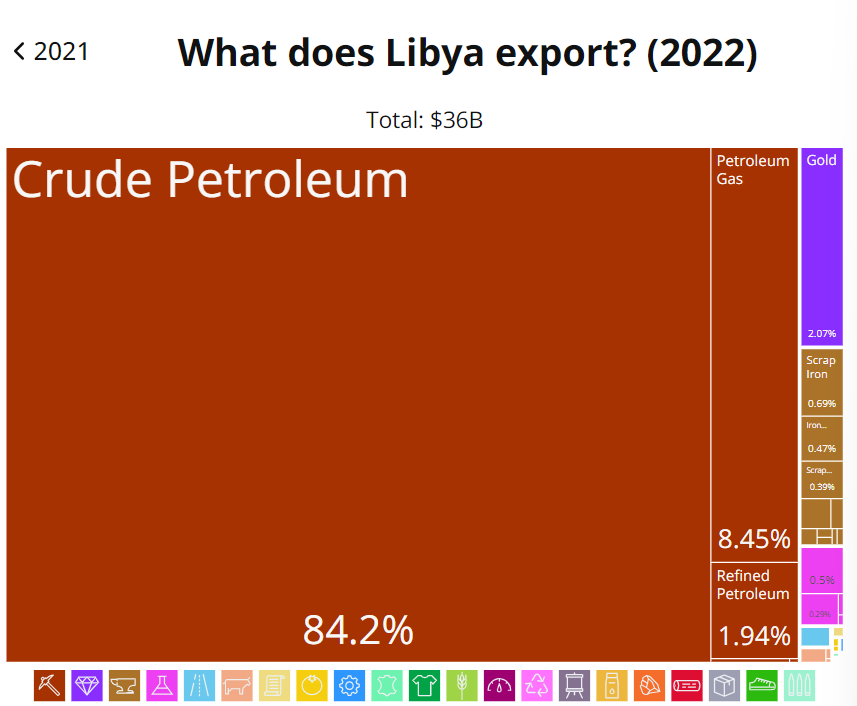

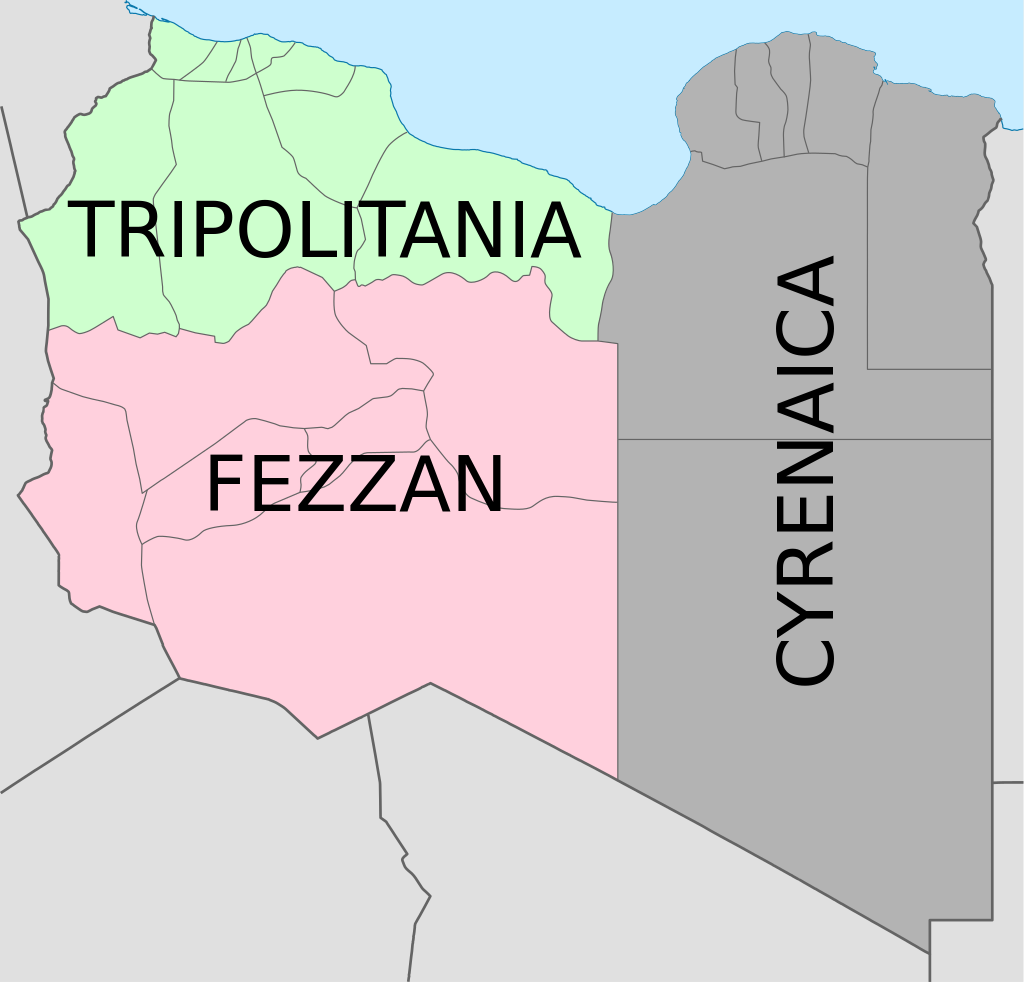
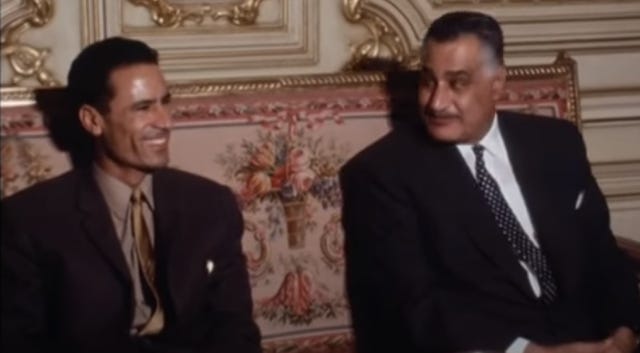




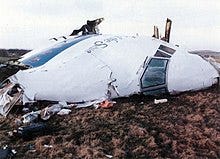
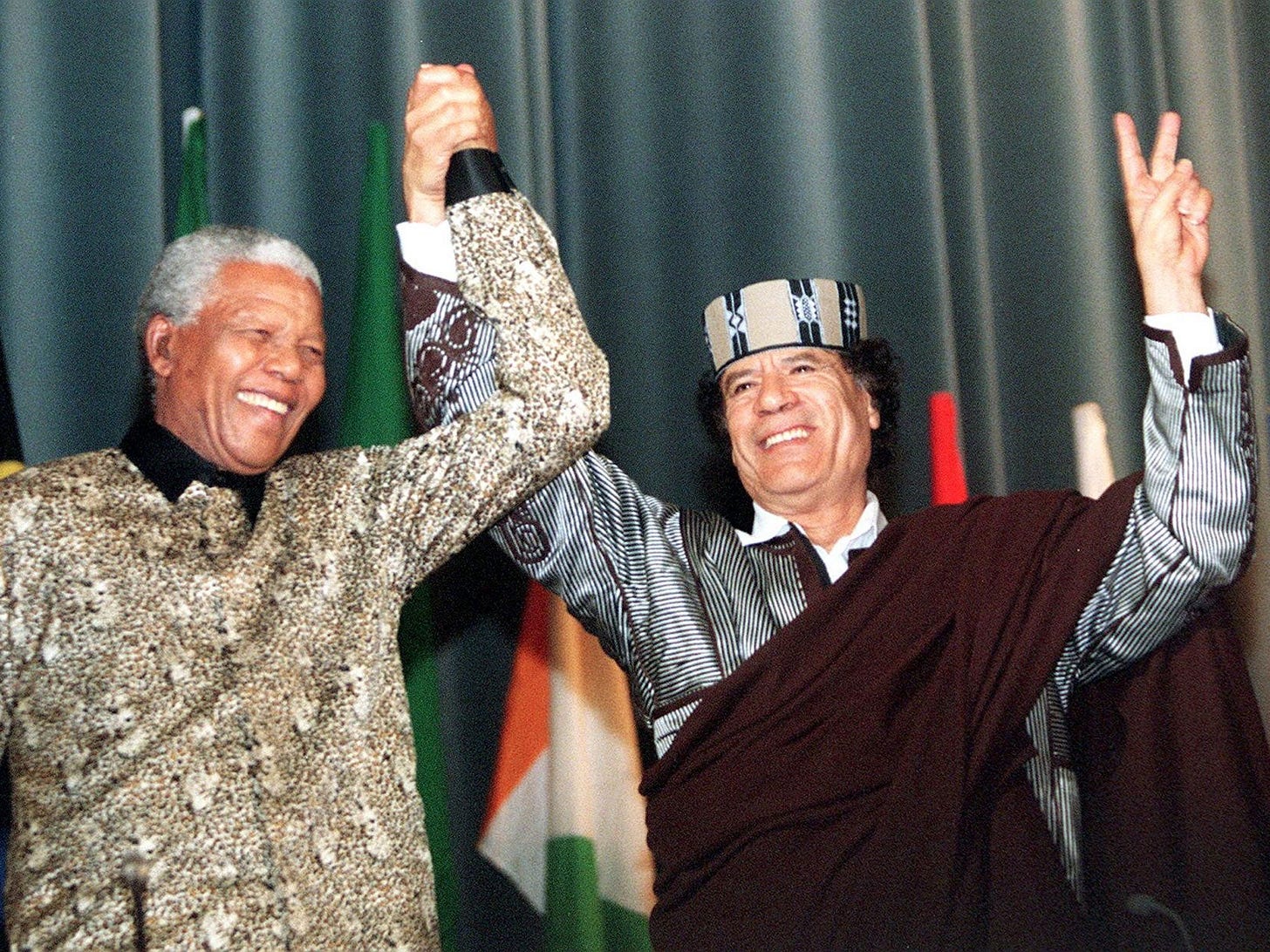





I'm not sure if you can describe sitting on a money printing machine as glory